In my experience up until now, white water rafting meant bathing suits, Chaco sandals, and the hottest days of July. But who has the patience to wait around for summer heat? Especially when spring floods create roiling rapids waiting to be conquered right now?
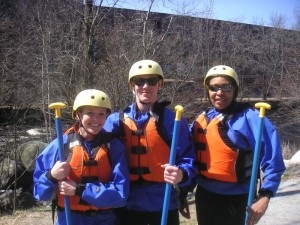
The folks at Zoar Outdoor asked themselves that same question 20 years ago, and have been rafting spring rivers in New England ever since.
After an April day of Spring White Water Rafting on the Concord River in Lowell, Mass (only 40 minutes from my home in South Boston), I can understand why they’re hooked!
White water rafting is like the most awesome water ride you remember from Six Flags, except ten times better (and ten times longer!). It is the ultimate aquatic roller coaster. Rafting the Concord River not only satisfied my thrill-seeking itch, it also turned out to be a history lesson!
The Concord River, a tributary of the Merrimack only fifteen miles long, is one of the most historically significant rivers in America. Paul Revere rode along its course (a ride you can now repeat on bicycles), and the Battles of Lexington and Concord (the first of the American Revolution) were fought here. The river also played a pivotal role in making Lowell, Massachusetts the birthplace of the American Industrial Revolution. Its mostly-demure waters made it ideal for transporting goods, and the canals built to do so gave Lowell the nickname “the Venice of America.”
But not all of the water is as calm as Henry David Thoreau’s first book, A Week on the Concord and Merrimack Rivers, would have you believe. The more feisty section of the river was our goal when my boyfriend Sam and I headed up from Boston to Lowell, a trip we made by car, but which can easily be accomplished by public transit.
Spring white water rafting on the Concord River starts in early April, when most people are still wearing heavy winter coats. I’ll admit I was nervous about getting into a river when it had snowed only a couple weeks before. To assuage my fears, I packed enough wool clothing to camp in the Arctic tundra. (Zoar recommends you bring wicking layers, but the second pair of wool socks was probably overkill.) Luckily, the Saturday we went saw the first sunny, 60° day of the year, and the wool sweaters and socks were left to bake in the car.
The sunny day wasn’t the only reason I didn’t need my extra layers though. The Concord River flows north and much of its water bubbles up from under ground. This water has been warmed by the earth, and is noticeably warmer than rivers that are filled in the spring with snow and ice runoff.
We still needed wetsuits though, which were provided by Zoar Outdoor, along with booties, spray jackets, helmets, PFDs (personal flotation devices, — fancy jargon for life jackets), and, most importantly, river guides! These professionals have not only learned to “read the water,” a valuable skill that takes time and practice, but have, they informed us, also successfully learned to distinguish right from left, and backwards from forwards.
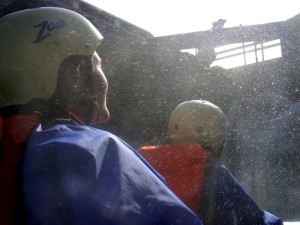
They taught us these oh-so-technical paddling commands, and before long we were headed into the first rapid: Twisted Sister. Just as I started to think that it would be an easy, fun ride, the nose of our raft plunged down into a big wave. I promptly fell into Sam, and Sam promptly fell into the water. My bad.
Fortunately, falling into the river, although not entirely desirable, isn’t that big a deal. Thanks to his PFD, Sam popped right up. The huge grin on his face told us he wasn’t minding the dunking. Before we’d launched, we’d been taught what to do if (when?) we fell in. We were instructed to get our feet pointed down river, and keep them up. The goal is to float like a board, and use your feet to absorb shocks and bounce off of rocks. Sam did exactly what he was instructed to do and floated through the entire rapid without mishap. We pulled him back into the raft in the next quiet section, and even his sunglasses made it back in good order. Falling into the river, at least when you have a PFD and know how to handle the situation, always turns out to be funny and makes for a good story.
I decided I would leave the glory of falling in to Sam though, so I tucked my feet tighter into to the side of the raft. We made it through the next twp rapids, Three Beauties and Middlesex Dam, with no great to-do, other than the fun, of course.
When we finished Three Beauties, and before the final plunge at Middlesex Dam, it was time to go surfing. I admit to being extremely confused about this when I heard we were going surfing, since we hadn’t brought surfboards, weren’t anywhere near the ocean, and surfing seemed out of the question anyway. Apparently, it was a different kind of surfing . . .
Here’s how it works: with a lot of effort on the paddles, especially from the guide, you slip the nose of your raft into a waterfall where the upwelling currents below the falls holds you in place for some adrenaline pumping, water roaring, wave riding. Great fun!
I enjoyed the surfing immensely, but I’d never seen anyone as excited about nearly being washed away as Joy, a first-timer who accompanied Sam and me in the raft. Her name suited her personality; she couldn’t get enough of the thrill, and her excitement was contagious.
Much to our delight, the other group with us managed to flip their raft while surfing! Watching it from a nearby eddy sent us all into fits of laughter, but I can’t imagine we had any more fun than the men thrown out of their raft.
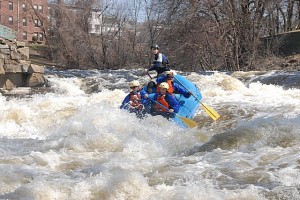
We surfed several times that afternoon, especially during the second run of the day.
Because the whitewater section of the Concord River is short, you run it twice, not only to double your fun, but to give you a different experience the second time down. At the end of the second run, rafters get an up-close look at the canals and Lower Locks that made Lowell famous.
Here’s how the canals work: you paddle in to the first part of the canal, and volunteers stand at the top of the old, heavy doors to open the “locks.” Water fills the first section of the canal, and the rafts just float up! After the water has risen enough, you paddle into the next section of the canal, and the same thing happens. Eventually we were at the top of the canal, right back at the check-in point where we’d started! A man from the other raft half-jokingly remarked, “Ah, the power of the Industrial Revolution.” It was fun to experience this part of American history firsthand, albeit in an entirely different way than the canals were originally built for.
Climbing out of the rafts and back on the dry land, I was grateful for the amazing day we’d had. Much of it is thanks to the Lowell Parks and Conservation Trust which has started working in tandem with Zoar to keep the Concord clean. Steve Conant, a local man who works closely with the Lowell Parks and Conservation Trust, told Sam and me about their efforts as we walked back to the meeting point.
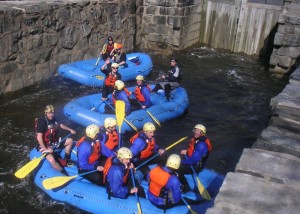
Steve explained that a portion of all proceeds from Zoar’s rafting trips go to the Conservation Trust, and have not only helped clean up the river, but also built a park across the street from the UMass Lowell Inn and Conference Center where we all met. Presently, they are building a bike trail along the length of the river.
Keeping the Concord River in good shape is not only about preserving an exciting river, it is also about preserving a piece of American history. This white water rafting trip celebrates our history, and is way more fun than any amusement park ride I’ve ever been on.
I can’t wait to continue white water rafting this summer, and I’m so glad I’ve gotten off to an early start. If you’ve never rafted before, you should get there soon so that you can soak up all that this season has to offer. Who knows, Zoar also offers whitwater kayaking clinics, and we might even be in kayaks together soon enough!


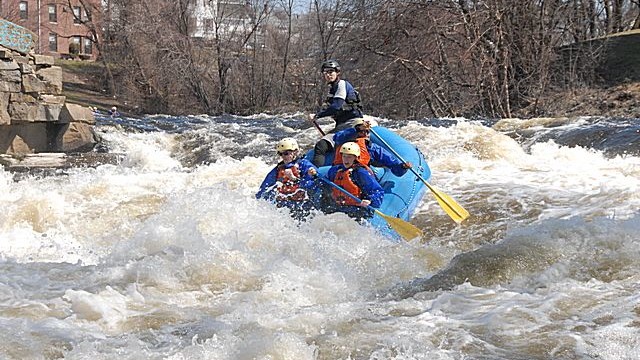
“the other raft that flipped” … piloted by me !!